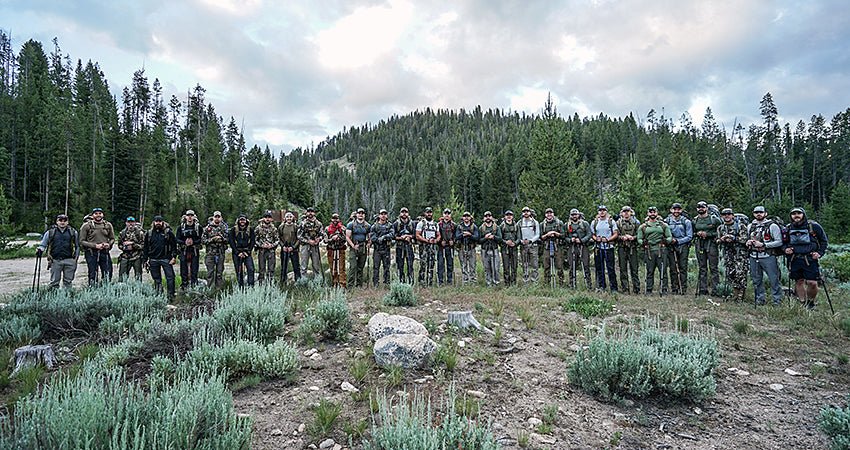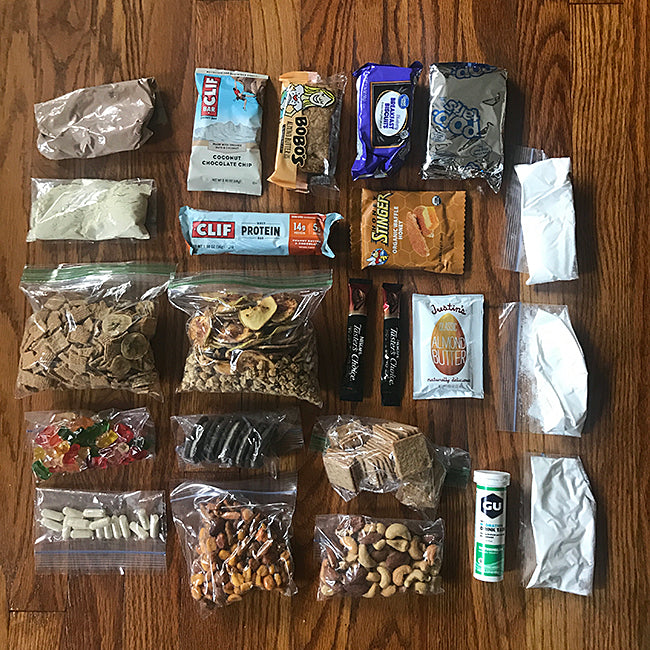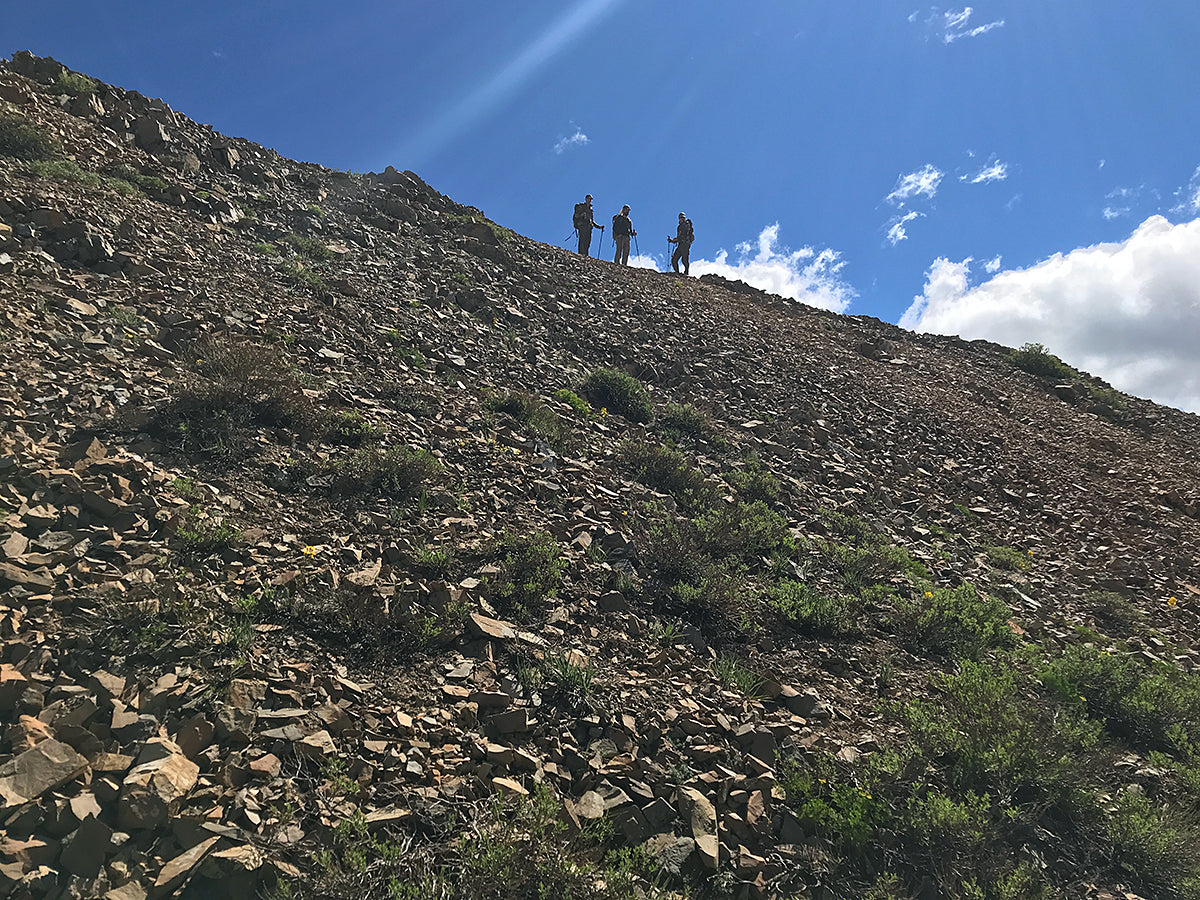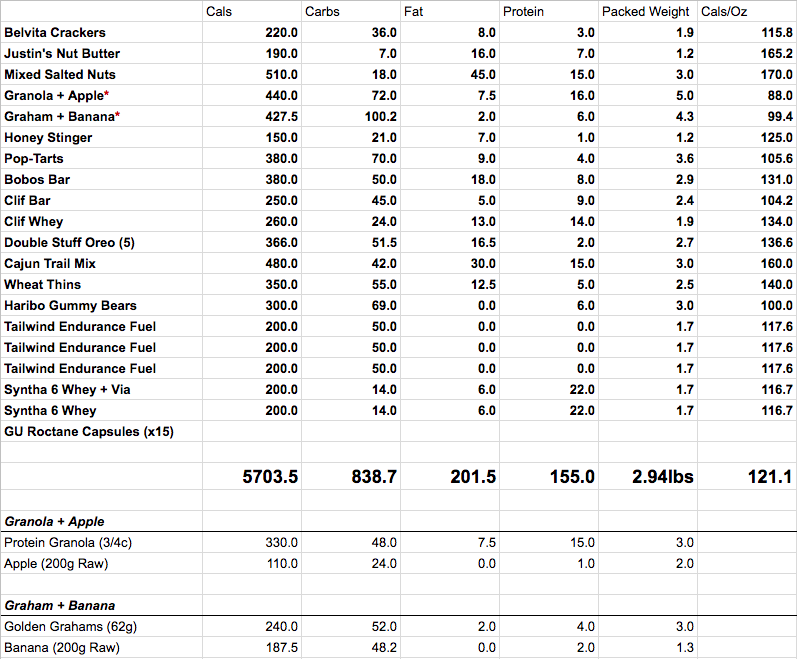Mark explains how he prepared for and packed for the 3 days, 90+ miles, and 21,000’ of climbing…

This was the fourth year that Exo Mtn Gear co-founders, Steve Speck and Lenny Nelson, gathered a group of guys to embark upon a challenging hike nicknamed “The Death Hike”. The hike has changed each year — the location, the distance, the terrain, and the participants. This year, thirty-one crazy fools showed-up to hike 90+ miles through some of Idaho’s most beautiful and rugged mountains. In the end, we hiked 92.5 miles and climbed over 21,000 feet in elevation in 3 days. Some of us took a few detours (got lost) and hiked even more. None of the past Death Hikes had been easy; but none of them could come close to this year’s distance and total vertical. Of the thirty-one that started, twenty-one completed each and every mile of the hike. Those other ten gents either dropped-out completely or sat-out portions of the hike. In the rest of this article I will discuss some of my preparation, thoughts on nutrition and gear, and link to the detailed food and gear lists that I used for this trip. If you have any questions, leave them in the comments below and I’ll do my best to answer them.
You can also hear more discussion about the hike, as well as the experience and lessons-learned from several of the other hikers by listening to Episode 133 of the Hunt Backcountry Podcast...
Subscribe in iTunes | Subscribe via Stitcher | Listen / Download at Sound Cloud
Preparation
Going into this year’s hike I knew that I needed to prepare. I also knew, however, that completing this hike was as much mental and logistical as it was physical. Sure, being in shape matters; but even the fittest will suffer on this type of pursuit. And when you suffer, it is the mind that must be strong. I have done plenty of physically and mentally challenging events in the past couple of years — a GoRuck Challenge, a Rim-to-Rim hike of the Grand Canyon, a long-distance trail race, a Spartan Race, last year’s Death Hike, and a lot of training between all of those events. I regularly hike 1-2 times a week, year-round, and more often as we get closer to hunting season. Each of those hikes is typically 5-10 miles with a varied weight and pace — lighter and faster, or heavier and slower. I only did 3 specific hikes to prepare for the Death Hike. On those hikes I did 15, 20, and 27 miles, trying to push the pace without breaks — constantly moving to accumulate fatigue in the feet and legs. On top of the physical and mental, my logistics needed to be on-point. My nutrition, footwear, clothing and gear needed to be tested and proven.
Nutrition

To dial-in my nutrition I worked directly with Kyle Kamp from Valley-to-Peak Nutrition. We had a podcast discussion with Kyle (Episode 124) and I continued to work with him after that discussion to build a custom plan for the hike. Kyle stressed the importance of simple, fast-acting carbohydrates for an effort like the Death Hike. Being a weight-conscious backpacker, I had typically done less carbohydrate and more fat on pack-in trips because that is what is most calorie dense and weight efficient. Adding in more Carbohydrate meant that my overall “calories per ounce” density would suffer. Additionally, being “a former fat kid”, I regularly eat a pretty clean diet and specifically avoid simple sugars. For both of those reasons, I had some hesitation about Kyle’s prescription, but I chose to trust Kyle’s scientifically-backed recommendations and try the approach for training. I tested myself on hikes by fueling with fat sources, fueling with fast carbohydrates, and going on fasted morning hikes. The difference was astounding, and simple sugars like gummy bears found their way into my pack for the Death Hike. Some of the other carbohydrate sources that I relied on were: Golden Grahams cereal mixed with dehydrated bananas, granola mixed with dehydrated apples, and Tailwind Endurance Fuel. Here is a complete breakdown of a day’s food for the trip:
As you can see, the total number of calories and carbohydrates is ridiculously high. I never thought I’d be carrying 3lbs of food for a single day, but I also didn’t think I’d ever be hiking 90+ miles in mountainous terrain either. In the end, this approach worked incredibly well. The total number of calories was spot-on, giving me enough energy for the long days and satisfying my appetite. I focused specifically on fueling with the simple carbs immediately before high-intensity efforts and during long climbs. I focused more on the balanced and dense foods during breaks, when my system would have some time to digest, and for recovery at night. I can’t say enough about how well this worked. Another thing that we have learned over the years with the Death Hike is the importance of staying on top of electrolytes and specifically supplementing sodium. Almost everyone had some sort of “salt pills” like Succeed S! Caps. Personally, I used Gu Roctane Electrolyte Capsules, taking one about each hour of hiking, and had a great experience with doing so.

Footwear
The crew of Death Hikers looked like a walking advertisement for Salomon and Altra footwear, with a few other brands thrown in. I tested the Altra Timp shoes a lot during my training and was mostly happy with them, but I made a somewhat last-minute call to rely on my “tried and true” Salomon Quest 4D boots for this hike. Ninety-five miles later, I didn’t have a single blister or hot spot, so they definitely worked for me. For socks, I wore the funny looking Injini toe socks. Specifically, the NuWool crew. These socks were perfect and kept my toes from rubbing on each other, preventing blisters. I packed one extra pair of socks and would rotate pairs every few hours, hanging the worn pair on the back of my pack so that they could dry out before the next change. I also packed my Crocs. Mine are actually a generic Wal-Mart version, which are lighter than the real thing — weighing-in at 10oz for the pair. I used the Crocs for camp shoes at night, to let my feet air out during breaks, and to add some protection for the many river and creek crossings we waded through. They were worth each and every ounce of the 10oz I carried. To take care of your feet on a hike like this, you have to air them out at breaks, change socks regularly, and be pro-active at treating any issues as soon as you feel the slightest discomfort. Hot spots should be addressed before they turn into full-on blisters. For that, most guys used Leukotape, which works really well and will hold its place for days. Your feet will swell on a hike like this, so keep that in mind when sizing for shoe or boot selection if you’re ever going to do a hike of this magnitude.
Clothing
I wore the same pants I wear for just about every hike, and hunt, and average day around the house — the Prana Stretch Zion. Not much to say, other than they’re damn near perfect. My top was an Outdoor Research Echo Hoody. This superlight long-sleeve provides great breathability and sun protection for the body, arms, neck and head. Another great choice, which a few of the guys were wearing, is First Lite’s new ultralight merino Wick Hoody. Those that didn't have a long-sleeve hoody needed to have plenty of sunscreen and some sort of cloth to cover their ears and neck. That, or they just fried. I wore a pair of 2XU compression underwear. They eliminate chaffing for me, which is a real issue on a long sweaty hike like this. Most guys turn to something like Anti Monkey Butt Powder for that issue (and it does work great), but I have found that with the right underwear I don’t develop any problems. The longer compression shorts also have the added bonus of providing some compression (support and recovery) to the hamstrings and quads. Besides what you’ll wear throughout the long days of hiking, the only other clothing item needed was a jacket for the cold nights. Something like the First Lite Uncompahgre or another lightweight down or synthetic insulation layer is great.
Sleep System
A good night’s rest is critical to prepare for another day of long hiking. With a favorable weather forecast, I chose to forgo a tent or tarp and just run my pad, bag, and bivy. The nights were cold, and I woke up to frost on my bag and bivy each morning, but I stayed toasty warm and comfortable. Because I packed-up my sleep system with frost and moisture on it, I took the time to air it out later in the day during breaks. The bivy I ran was the Enlightened Equipment Recon, which is superlight, while still providing some good “features” like structured corners, stake-out points, and adjustable shock cords at the head and foot to bring the fabric up off your body. For a pad I tried the new Big Agnes AXL and found it to be lightweight, sufficiently warm and comfortable to sleep on. No complaints, other than I’d like to see a “quick dump” air valve for deflation. I ran a Katabatic Gear Alsek 22-degree quilt, which I decided to try after talking with the owner of Katabatic on Episode 130 of the podcast. I have spent some time in quilts before but wasn’t quite satisfied with them. For the past couple of years, I have been running the Nemo Argali, which is sort of a hybrid between a bag and a quilt. After spending some nights in the Katabatic, it gives me the warmth, comfort, and freedom of movement I’m looking for, but also allows me to save some more weight. I’m loving it. Here is a complete breakdown the gear I packed and wore/carried on the trip:
Download Gear List Spreadsheet
Other Gear
Beyond food, clothing, footwear, and sleep system, the rest of the gear is super minimal. I packed personal items (toothbrush and toilet paper), some emergency/repair items (first-aid, medications, blister repair, extra batteries), a good headlamp (Black Diamond Spot), a Garmin InReach Mini for communications, and a power bank (Dark Energy Poseidon) to top-off my phone, headlamp, and InReach. The one oddity or luxury item I packed on this trip was a ball to roll out tight muscles and joints on breaks and in camp. It was shared among the group and was worth the 6oz it cost me to pack it. Other notable items, which were used constantly, were sunglasses and trekking poles. The sun glasses help eye fatigue, and for me, prevent headaches. They were also super important when in the snowy areas of the high-country passes. Trekking poles are an absolute must. The difference in using them, especially on a long hike like this, cannot be overstated. I find them particularly critical for support on downhill sections, but they work great for climbing and even provide some efficiency on level ground as well. I started the hike with the Leki trekking poles I have been using for years, but after losing one (don’t ask!), I swapped over to a prototype of the trekking poles that Steve developed and is releasing through S&S Archery this summer. Those new poles were significantly lighter than my Lekis, but proved to be just as solid.

What the Death Hike Taught Me
The most important things I took away from this year’s hike have nothing to do with gear or nutrition, although I did learn a few important things there. More than tangible items, I learned about myself — about what I am capable of, about what “limits” are, about how to push past them, and about how my mind and body are so connected and can either work for or against each other. And I learned a great deal about good men. I saw firsthand how struggles became more bearable when the hurting are surround by people that believe in them. I witnessed how pain can be set aside to achieve a bigger goal. I saw how small gestures of support can have massive impact. Hopefully we all learn to live this way more often.
Your Turn
What’s holding you back from doing something like this? You don’t have to join us, you don’t have to find 30 other guys, and you don’t have to be in Idaho. Find some friends, map a route, and test yourself. If you have any questions, just let us know...


